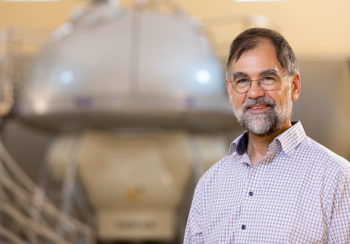The University of Georgia Complex Carbohydrate Research Center (CCRC) is now home to a new, multimillion-dollar 1.1 gigahertz nuclear magnetic resonance (NMR) spectrometer, giving UGA one of the most powerful such instruments in the world.
The approximately 10-ton machine was installed at CCRC on June 25 with the help of a large construction crane. Counterweighted with multiple 10-ton steel plates, the crane lowered the NMR spectrometer through a hatch built into the CCRC roof expressly for this purpose. UGA is now one of only four U.S. institutions to possess an NMR of this size.
“This new instrument will help us to push the frontiers of NMR forward,” said Art Edison, GRA Eminent Scholar in NMR Spectroscopy at the CCRC. “There are several benefits it will provide, one of the most important for our research being improved resolution.
“Samples such as complex carbohydrates or metabolite mixtures are both critical in biology but are extremely overlapped and difficult to interpret,” Edison said. “This 1.1 GHz instrument will improve our ability to study these types of biological molecules and ultimately to learn more about how they relate to human disease and basic biology.”
The new NMR was acquired through a $40 million National Science Foundation project called the Network for Advanced Nuclear Magnetic Resonance (NAN), awarded in 2021 as a collaboration among UGA, University of Wisconsin-Madison (UW-M), and University of Connecticut School of Medicine. UW-M is home to one of two other 1.1 GHz machines, along with St. Jude Children’s Hospital (Ohio State University has a 1.2 GHz machine).
Edison is co-principal investigator on the NAN project. One of its goals—akin to those of the recent, $18 million NSF BioFoundry award to CCRC—is to democratize use of NMR technology and make instruments like the new UGA machine available to a much wider population of scientists and researchers. The NAN network is based upon its member institutions’ expertise; UGA and UW-M are home to high-end instruments like the 1.1 GHz NMRs, while UConn has the computational expertise and resources to manage the extremely high volume of data that comes from machines that powerful.
“We have similar goals for this machine as those for the BioFoundries—to facilitate much wider use than has happened in the past,” said Jim Prestegard, GRA Eminent Scholar Emeritus and one of the architects of CCRC’s NMR lab. “In the past, only experts used these machines. Now our collaborators are being encouraged to provide more samples and take more responsibility for the experiments we run with them.”
NMR technology works in the same manner as the magnetic-resonance imaging (MRI) machines located in hospitals and health care facilities around the world. It involves putting a material sample in glass vial, which is placed inside the NMR, essentially a powerful magnet. The machine then bombards the sample with radio waves and observes the spin of nuclei within the test sample.
The instrument’s magnetic field is created through an electric coil that is cooled with liquid helium to about 2 Kelvin—just above absolute zero (-460 degrees Fahrenheit). The extremely low temperature nullifies electric resistance in the superconducting coil and allows more current to pass through, creating a stronger magnet. The lack of resistance also means, once the machine is charged, with proper maintenance it does not need to be charged again; CCRC has smaller NMRs that have been running continuously on their initial charge for decades.
Bruker, a life sciences technology company headquartered in Billerica, Massachusetts, manufactured both the 1.1 GHz machine and other NMRs housed at CCRC.





